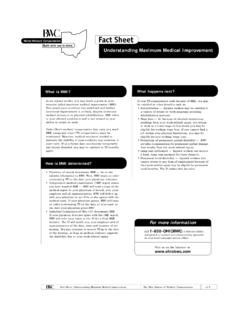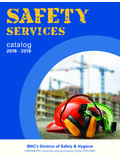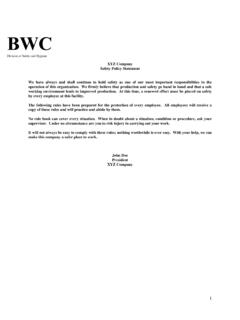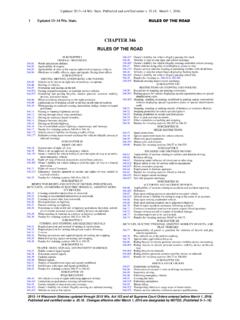Transcription of AN OBJECTIVE SET OF GUIDELINES FOR PUSHING AND …
1 AN OBJECTIVE SET OF GUIDELINES FOR PUSHING AND PULLING Eric B. Weston, Alex Aurand, Jonathan S. Dufour, Gregory G. Knapik, W. Gary Allread, William S. Marras Spine Research Institute, The Ohio State University, Columbus, OH USA BACKGROUND Occupationally-related low back disorders (LBD) and shoulder musculoskeletal disorders are a leading cause of lost work days and are a costly occupational safety and health problem facing industry today. In the United States, treatment of low back pain costs over $50 billion annually in direct costs alone, while the direct cost of treating shoulder injury is over $7 billion (Meislin et al. 2005 ; Davis et al 2012). As employers have recognized the risks associated with lifting, they have shifted the manual materials handling burden to interventions involving PUSHING and pulling (such as overhead hoists, carts, and articulating arms).
2 However, PUSHING and pulling is also associated with its own risk of injury to the low back and shoulders as well. GUIDELINES presented to practitioners have the potential to aid in workplace design and reduce the risk of low back and shoulder injuries. However, the only current PUSHING and pulling GUIDELINES were developed subjectively, relying on the assumption that an individual s perception of maximum acceptable external forces corresponds to biomechanical risk to the low back and shoulders (Snook and Ciriello 1991). Prior literature shows this assumption is incorrect (Jorgensen et al. 1999; Davis et al. 2000; Le et al. 2012). Thus, objectively determined GUIDELINES are necessary for PUSHING and pulling. This study used biomechanical information collected from 62 human subjects in a laboratory to develop PUSHING and pulling GUIDELINES for practitioners.
3 This was achieved via establishing a relationship between the biomechanical loads induced onto the spine and hand forces generated by the participants. Risk limits were determined by investigating which hand forces or turning torques led to spinal loads over risk thresholds (Gallagher and Marras 2012; NIOSH 1981). Loads on the spine were predicted using a unique biomechanical model that is validated for PUSHING and pulling, dynamic, and accurately accounts for the way each person recruits their muscles to complete a task (Granata and Marras 1993; Hwang et al. 2016; Knapik and Marras 2009). Subjects performed activities including 1 Handed Pulling, 2 Handed Pulling, and 2 Handed PUSHING . They performed exertions at three different handle heights (32 in, 40 in, 48 in) and performed both straight and turning push/pull exertions.
4 RECOMMENDATIONS FOR WORKPLACE DESIGN The results of this study suggest that the following be considered related to PUSHING and pulling. Higher handle heights (up to 48 in.) are generally preferable for all PUSHING and pulling exertions. Turning push/pull exertions should be avoided where possible because these exertions generally subjected participants to higher biomechanical loads than straight exertions. Two handed turning exertions (such as moving a cart) are recommended over one handed turning exertions (such as moving a pallet jack). The widely-accepted subjectively determined limits for hand force during PUSHING and pulling (Snook and Ciriello 1991) are not protective enough of injury risk. The OBJECTIVE , biomechanically-determined risk limits derived from our study are up to 30% lower than the limits reported previously.
5 GUIDELINES FOR OCCUPATIONAL PUSHING AND PULLING The objectively determined GUIDELINES are presented in tables below. These limits and are expected to be protective of both the low back and shoulders. Note that the PUSHING and pulling GUIDELINES proposed within this investigation did not differ based on gender. SUMMARY Current GUIDELINES related to PUSHING and pulling commonly used by practitioners were developed using subjective methods and may underestimate risk to the lower back and shoulders. This document describes the development of a new set of OBJECTIVE GUIDELINES and how to implement them moving forward to help reduce the risk of workplace injury to the low back and shoulders. USING THE GUIDELINES It will be necessary to enter several pieces of information about the push/pull task being tested into the online web interface in order to estimate biomechanical risk.
6 This includes simple characteristics about the exertion such as the action being performed (1 Handed Pull, 2 Handed Pull, 2 Handed Push) and the exertion type (a straight push or pull or a turn). Practitioners will also need to measure maximum push/pull force required to move the object and the hand height from the ground (in inches). Measuring Maximum Push/Pull Forces Hand forces and torques can easily be measured in the field using a dynamometer (Figure 1a). For PUSHING , the practitioner should be able to push directly on the handle(s) of the object being pushed. For pulling, the practitioner may choose to attach a rope to the handles and use the dynamometer s hook attachment. Examples are shown in Figure 1. Figure 1. Measurement of PUSHING and pulling forces using (a) a dynamometer for (b) PUSHING and (c) pulling.
7 The practitioner should place the hand dynamometer (or rope) where a workers hand would usually make contact with the object that is to be moved. After placing the hand dynamometer in the correct location, the practitioner should record the maximum forces required to move (push, pull, turn) an object (in pounds). This maximum force is the best indicator of the risk associated with performing a particular job. Most of the time, this will be the hand force or turning torque required to initiate movement of the object from a standstill. However, it is important to note that some occupational exposures such as PUSHING or pulling a cart up a ramp might require higher PUSHING and pulling forces than initiating motion. In an occupational environment, the direction that PUSHING and pulling forces are applied by workers is largely dependent on the handle height or weight of the object being pushed or pulled.
8 However, when collecting data regarding PUSHING and pulling in order to apply the GUIDELINES set forth herein, practitioners should record forces applied horizontally relative to the ground. This recommendation mirrors recommendations set forth by preexisting PUSHING and pulling GUIDELINES and will ensure greater consistency in measurement. Measuring Hand Height Practitioners should measure the vertical height of the hands from the floor. The measure should be taken where the worker s hands would normally be on the handle. The GUIDELINES accommodate hand heights of 32 to 48. Measuring Hand Distance In two handed turning exertions, it will also be necessary to record a measure hand distance (in inches), detailed further in Figure 2 below. Application of two handed turning GUIDELINES assumes that the hands are centered on the object being turned.
9 These GUIDELINES were also developed assuming the hands are placed approximately shoulder width apart when turning. The GUIDELINES accommodate hand distances of 12 to 36 and are not applicable for significantly wider or narrower hand distances. Figure 2. Calculation hand distance in two-handed push/pull turns, such as with a four-wheeled cart. Note: In one handed turning exertions, measurement of hand distance (or an equivalent moment arm) is not necessary. The same limits can be applied for both straight 1 Handed Pulling and turning 1 Handed Pulling. Interpreting Risk After entering all of the necessary information, the web interface will calculate the risk associated with performing that particular type of exertion and assign it a risk level of either green, yellow, or red (Figure 3).
10 Green. The exertion is safe for at least 80% of the working population. This exertion may be viewed as acceptable. Yellow. The exertion is safe for 50-80% of the working population. It is recommended that changes to the task be made to make it safer for more people. Red. The exertion is safe for less than 50% of the working population. It is strongly recommended that changes to the task be made to make it safer for more people. Figure 3. Risk levels as outputs to the online push/pull GUIDELINES and their meaning to the practitioner. GUIDELINES FOR STRAIGHT PUSHING AND PULLING WITH TWO HANDS (LIMITS IN LBS.) Action Hand Height (inches) Most Protective (Green) Moderate (Yellow) Least Protective (Red) 80+% population protected 50-80% population protected <50% population protected 2 Hand Pull 32 inches 41 lbs. or less 42-57 lbs. 58 lbs. or more 33 inches 44 lbs.











